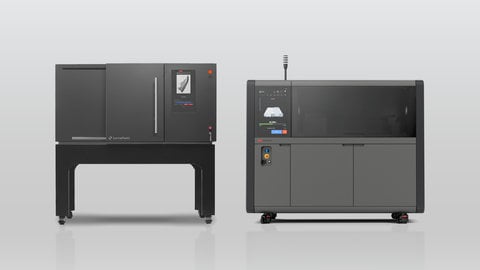Desktop Metal and Lumafield Introduce Supply Chain Resilience Solution to Help Manufacturers Easily Scan and 3D Print Parts
CT scanning and 3D printing package can quickly and accurately produce high-demand parts without original CAD models.

To address the manufacturing industry’s supply chain challenges, Desktop Metal and Lumafield, a startup offering the world’s first accessible industrial X-ray CT platform, today announced they would team up to offer an easy system to scan and 3D print in-demand parts in plastic or metal. (Photo: Business Wire)
Desktop Metal, Inc., a global leader in additive manufacturing technologies for mass production, and Lumafield, a startup offering the world’s first accessible industrial X-ray CT platform, today announced a complete solution to help manufacturers quickly and accurately produce high-demand parts with an easy system to scan and 3D print.
As a result of the COVID pandemic, manufacturers have been faced with historic supply chain disruptions, along with wide swings in pricing and inventory – a challenge highlighted by the Biden Administration’s recent announcement of the AM Forward initiative to strengthen U.S. supply chains by supporting adoption of additive manufacturing (AM), or industrial 3D printing.
Additive manufacturing offers the ability to cost-effectively in-source production and reduce supply chain risk, but often requires manufacturers to have CAD models of their parts. That has been a significant barrier; manufacturers often rely on thousands or millions of parts, many of which were designed years ago and don’t have associated CAD files. 3D scanning has been proposed as a solution, but it’s limited to capturing exterior part features.
The Supply Chain Resilience package from Desktop Metal and Lumafield closes that gap by joining 3D printing with X-ray computed tomography, also known as CT scanning. The combination of these technologies allows manufacturers to scan old parts and reproduce them quickly in a variety of materials using 3D printing.
Lumafield’s CT platform digitizes parts with a series of X-ray images that capture both external and internal features in detail, using powerful cloud-based software to create a 3D model that can be exported as a mesh representation for 3D printing.
Desktop Metal’s software and 3D printers can then turn those mesh models back into high-quality metal or polymer parts, making it possible to seamlessly replace legacy manufacturing processes with in-house 3D printing.
“Manufacturers have wanted to replace legacy fabrication processes with 3D printing for a long time, but digitalization of parts has been a barrier,” said Ric Fulop, Founder and CEO of Desktop Metal. “With accessible CT scanning, we finally have the digitization solution we need to quickly convert old designs into complete CAD files for 3D printing.”
“The last two years have been profoundly disruptive, and we cannot expect our supply chains to return to normal,” said Eduardo Torrealba, Co-Founder and CEO of Lumafield. “Fortunately, we now have the technology to seamlessly bring production in-house, taking control of our supply chains and reducing risk.”
Supply Chain Resilience Package Details
Customers interested in pairing a Lumafield scanner with a Desktop Metal printer can customize the solution that best fits their needs.
Desktop Metal printers initially included in this offering include:
- All metal printers, including the Desktop Metal Shop System™, which was built as a turnkey solution for smaller enterprises and is offered in a 4-, 8-, 12- or 16-liter package. Also included: the Studio System™, X-Series and all Production System™ models, which includes the P-1 and P-50 – the latter of which is the world’s fastest system to 3D print metal parts at scale.
- All ETEC DLP polymer 3D printing systems, which includes the D4K, P4K, Envision One XL or Xtreme 8K, which offer a wide range of price points, build volumes and potential polymer material sets, including elastomers, hard plastics, high temperature plastics, and biocompatible materials.
Lumafield’s Neptune scanner is a revolutionary advance over legacy CT systems. It’s at home in any office or workshop environment, ready to become an everyday tool for entire engineering teams. With a user-friendly touchscreen and AI-powered configuration, anyone can use it with minimal training—no dedicated operator required.
Lumafield’s cloud-based Voyager software turns scans into actionable insights and is included with every Neptune scanner. In addition to producing mesh exports for 3D printing, it offers intuitive visualizations that reveal invisible features, measurement tools that take guesswork out of inspection, and a powerful automated analysis engine that pinpoints voids, pores, and cracks before they turn into critical problems. Voyager runs in the cloud, accessible through any desktop web browser, so teams can collaborate and share data in real time.
The Supply Chain Resilience package is available to any company that purchases a Desktop Metal 3D printer and reserves a Lumafield CT scanner between May 1 and July 1, 2022. Customers will be entitled to a package benefit of 15 CT scans and application engineering support through Lumafield’s scanning service while they wait for delivery of their Neptune scanner, currently expected to take place in the fourth quarter of 2022.
www.desktopmetal.com

